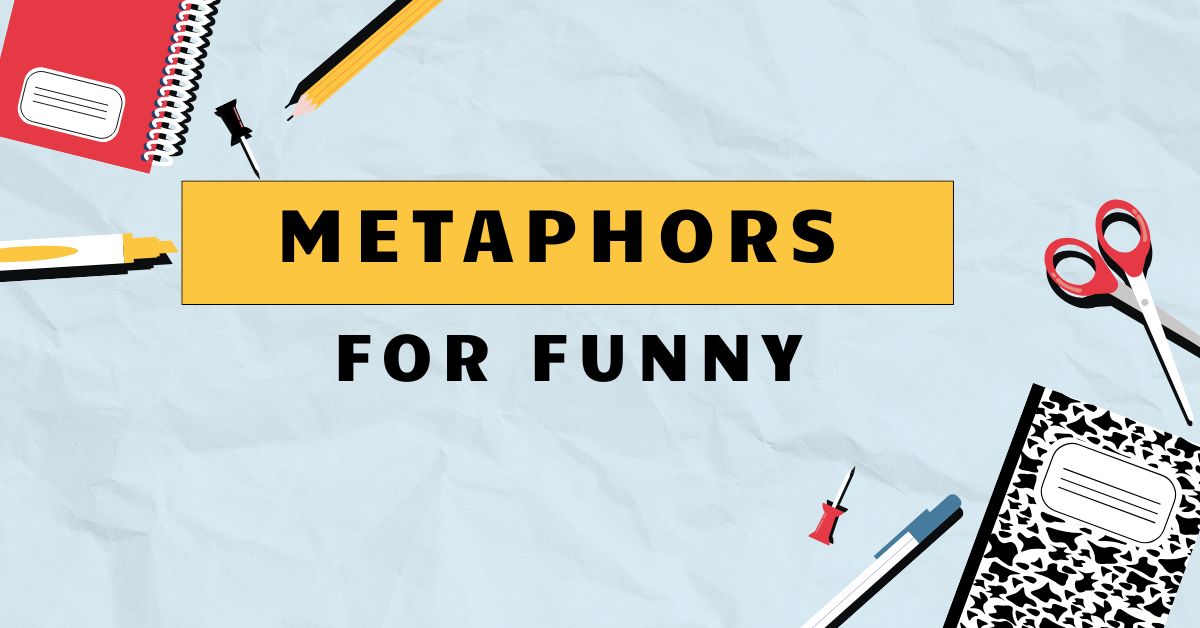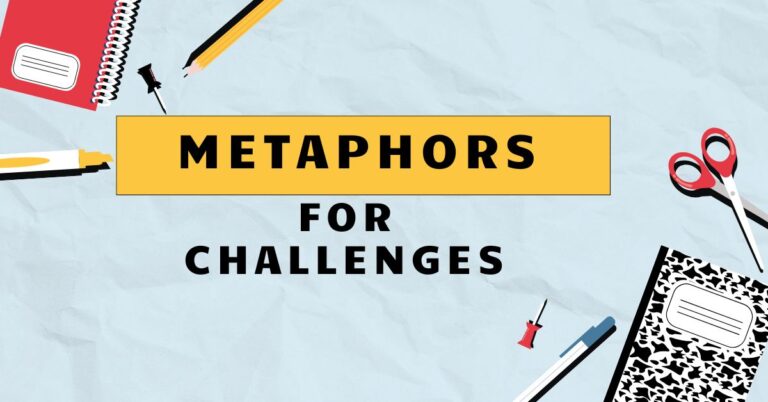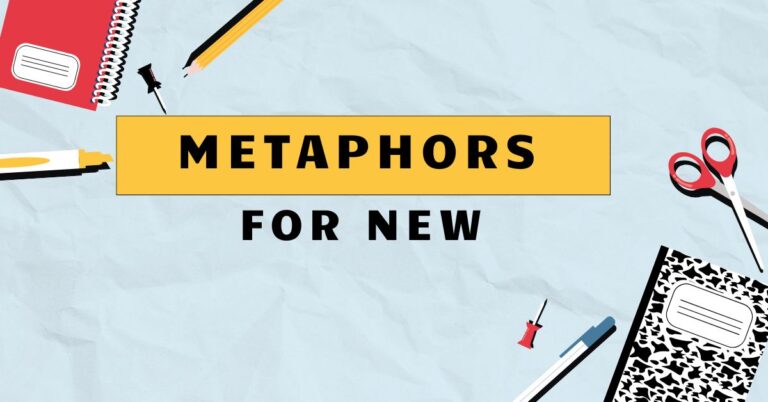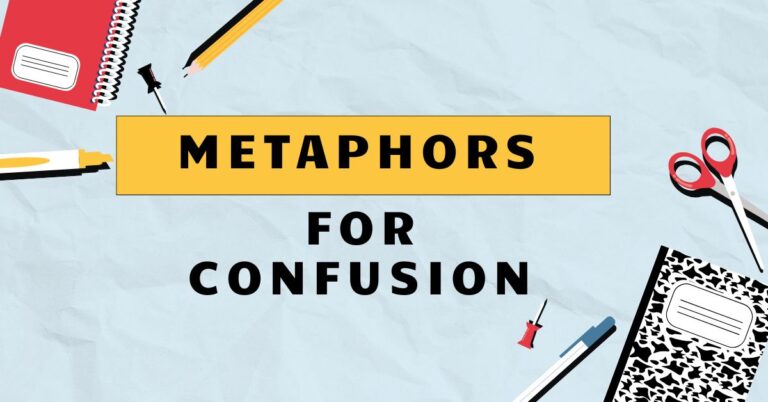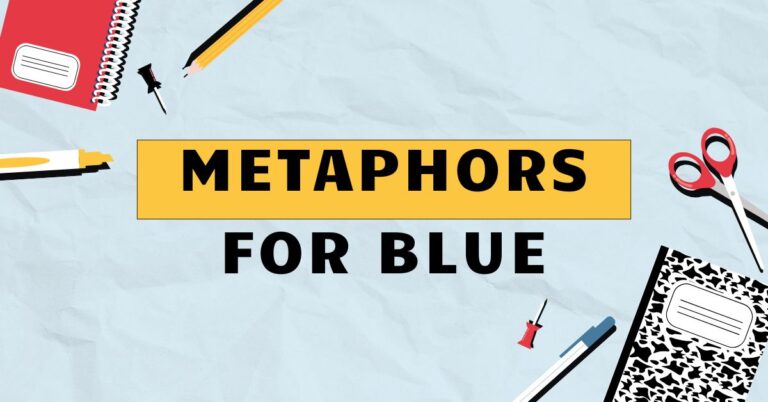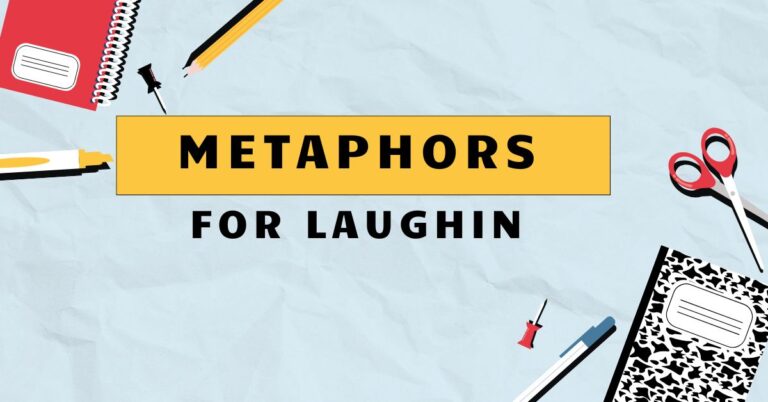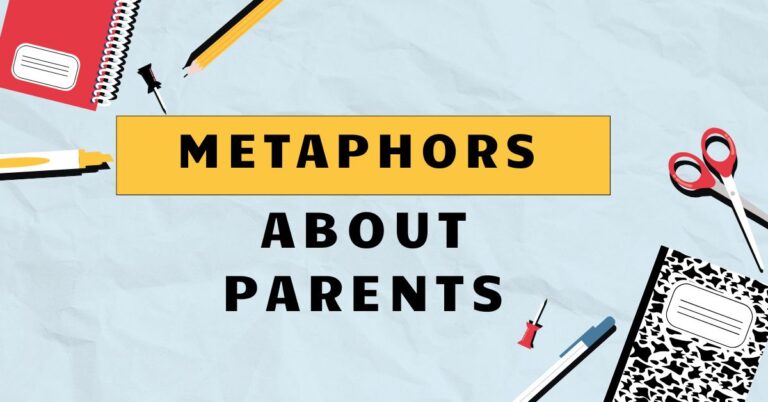30 Metaphors for Funny: Understanding Figurative Language
Metaphors are a powerful tool in the English language, allowing us to express complex ideas and emotions in vivid and relatable ways. When used to describe humor, metaphors can elevate a simple joke or observation into something truly memorable and impactful.
Understanding how metaphors function in the context of humor not only enhances our appreciation of comedic art but also sharpens our communication skills. This article delves into the world of “funny” metaphors, exploring their structure, function, and various forms.
This guide is perfect for English language learners, writers, comedians, and anyone interested in exploring the nuances of figurative language and humor.
This article will provide a comprehensive overview of metaphors related to humor, including their definition, structural breakdown, and various types. Through numerous examples and practice exercises, you will learn to identify, understand, and even create your own humorous metaphors, enriching your understanding of both language and comedy.
Table of Contents
- Introduction
- Definition of Metaphors for Funny
- Structural Breakdown of Funny Metaphors
- Types and Categories of Funny Metaphors
- Examples of Metaphors for Funny
- Usage Rules for Funny Metaphors
- Common Mistakes with Funny Metaphors
- Practice Exercises
- Advanced Topics in Funny Metaphors
- Frequently Asked Questions
- Conclusion
Definition of Metaphors for Funny
A metaphor is a figure of speech that directly compares two unrelated things, asserting that one thing *is* another, for rhetorical effect. Unlike similes, which use “like” or “as” to make a comparison, metaphors imply a similarity, creating a more vivid and often more impactful image in the reader’s or listener’s mind.
When applied to humor, metaphors can be used to describe the feeling of amusement, the quality of a joke, or the characteristics of a comedian, among other things.
In the context of “funny” metaphors, we’re talking about using figurative language to describe something related to humor. This could include the feeling of laughter, the quality of a joke, or even the personality of a comedian.
For example, saying “That joke was a nuclear explosion of laughter” uses a metaphor to convey the power and impact of the joke.
The function of a metaphor in this context is to enhance understanding and create a memorable image. Instead of simply saying something is funny, a metaphor provides a richer, more evocative description.
Metaphors bridge the gap between abstract concepts (like humor) and concrete experiences, allowing us to grasp the essence of the joke or comedic situation more effectively.
Structural Breakdown of Funny Metaphors
Understanding the structure of a metaphor can help you identify and create them more effectively. A typical metaphor consists of two main elements: the **tenor** and the **vehicle**.
The tenor is the subject being described (e.g., a joke), while the vehicle is the thing used to describe the subject (e.g., a rollercoaster). The connection between the tenor and the vehicle is the shared characteristic or quality that the metaphor highlights.
For example, in the metaphor “His stand-up routine was a rollercoaster of emotions,” the tenor is “his stand-up routine,” and the vehicle is “a rollercoaster.” The shared characteristic is the unpredictable and exciting nature of both. The metaphor works because it implies that the routine had highs and lows, twists and turns, keeping the audience engaged and entertained.
The effectiveness of a metaphor depends on the clarity and relevance of the connection between the tenor and the vehicle. A good metaphor should be easy to understand and create a vivid image in the mind of the audience.
If the connection is too obscure or far-fetched, the metaphor may fall flat and fail to communicate the intended meaning.
Types and Categories of Funny Metaphors
Metaphors for “funny” can be categorized in several ways, depending on the type of comparison being made. Here are some common categories:
Physical and Sensory Metaphors
These metaphors use physical sensations or descriptions to convey the feeling or quality of humor. They often relate to sight, sound, touch, taste, or smell.
For example, describing a joke as “sharp” (touch) or “bright” (sight) falls into this category. These metaphors tap into our immediate sensory experiences, making the humor feel more tangible and relatable.
Animal-Related Metaphors
Animal-related metaphors compare humor to the characteristics or behaviors of animals. This can be used to describe the wildness of a comedic performance or the slyness of a witty remark.
For example, calling a comedian “a comedic wolf” suggests a cunning and predatory approach to humor. These metaphors often leverage our preconceived notions about animal behavior to create a specific impression.
Abstract Concept Metaphors
These metaphors compare humor to abstract ideas or concepts, such as mathematics, science, or philosophy. For example, saying a joke is “the square root of hilariousness” connects humor to a mathematical concept, implying a precise and calculated form of wit.
These metaphors can add a layer of intellectual depth to the description of humor.
Situational Metaphors
Situational metaphors describe humor in terms of specific situations or events. For instance, comparing a comedy show to “a circus of laughter” evokes a lively and chaotic atmosphere.
These metaphors paint a picture of the environment or context in which the humor is experienced.
Examples of Metaphors for Funny
To further illustrate the concept of metaphors for “funny,” let’s explore some specific examples within each category.
Physical and Sensory Examples
The following table provides examples of metaphors for funny that use physical and sensory language. These examples aim to illustrate how sensory experiences can be linked to the abstract concept of humor.
| Metaphor | Explanation |
|---|---|
| That joke was razor-sharp. | Implies the joke was incisive and clever. |
| Her wit was blindingly bright. | Suggests her humor was intelligent and radiant. |
| The comedian served up a spicy set. | Indicates the performance was exciting and bold. |
| His jokes were as smooth as silk. | Conveys that his humor was effortless and refined. |
| The punchline hit like a ton of bricks. | The joke was impactful and surprising. |
| The comedian’s delivery was ice-cold. | The delivery was detached and emotionless, adding to the humor. |
| Her jokes were a warm blanket on a cold night. | The jokes were comforting and enjoyable. |
| His humor was a volcanic eruption of laughter. | The humor was explosive and uncontrollable. |
| The comedian’s timing was as precise as a Swiss watch. | The timing was perfect and accurate. |
| Her jokes were a sweet treat for the audience. | The jokes were delightful and satisfying. |
| His humor was a bitter pill to swallow for some. | The humor was controversial or challenging. |
| The comedian’s voice was a velvet hammer. | The voice was both gentle and impactful. |
| Her jokes were a rainbow after a storm. | The jokes were uplifting and joyful after a difficult time. |
| His humor was a rollercoaster of emotions. | The humor was exciting and unpredictable. |
| The comedian’s presence was electric. | The presence was energizing and captivating. |
| Her jokes were as light as a feather. | The jokes were easy and enjoyable. |
| His humor was a soothing balm for the soul. | The humor was comforting and healing. |
| The comedian’s words were like daggers. | The words were sharp and cutting. |
| Her jokes were a symphony of laughter. | The jokes were harmonious and beautiful. |
| His humor was a tidal wave of amusement. | The humor was overwhelming and powerful. |
| The comedian’s delivery was as sharp as glass. | The delivery was precise and cutting. |
| Her jokes were as refreshing as a cool breeze. | The jokes were invigorating and pleasant. |
| His humor was a punch to the gut. | The humor was impactful and surprising. |
Animal-Related Examples
The following table provides examples of metaphors for funny that use animal-related comparisons. These metaphors often draw on common associations with different animals to convey specific qualities of humor.
| Metaphor | Explanation |
|---|---|
| He’s a comedic wolf, always hunting for the next laugh. | Suggests the comedian is cunning and skilled at getting laughs. |
| Her jokes were like a flock of pigeons, scattering laughter everywhere. | Implies her humor was widespread and infectious. |
| The comedian was a sly fox on stage. | Indicates the comedian was clever and mischievous. |
| His humor had the bite of a viper. | Conveys that his jokes were sharp and potentially venomous. |
| The joke was a sleeping bear, waking up with a roar of laughter. | The joke was initially subtle, but then became extremely funny. |
| Her jokes were like playful kittens, always entertaining. | The jokes were lighthearted and amusing. |
| His humor was like a stubborn mule, refusing to be ignored. | The humor was persistent and hard to dismiss. |
| The comedian was a graceful swan on stage. | The comedian was elegant and poised. |
| Her jokes were like a swarm of bees, buzzing with energy. | The jokes were lively and filled with excitement. |
| His humor was like a roaring lion, commanding attention. | The humor was powerful and attention-grabbing. |
| The comedian was a wise owl, dispensing witty observations. | The comedian was intelligent and insightful. |
| Her jokes were like a school of fish, moving in perfect harmony. | The jokes were well-coordinated and flowed seamlessly. |
| His humor was like a chameleon, adapting to any audience. | The humor was versatile and adaptable. |
| The comedian was a playful dolphin, entertaining the crowd with tricks. | The comedian was fun-loving and engaging. |
| Her jokes were like a spider web, catching everyone in their laughter. | The jokes were intricate and captivating. |
| His humor was like a peacock, extravagant and attention-grabbing. | The humor was flamboyant and showy. |
| The comedian was a busy beaver, constantly crafting new jokes. | The comedian was diligent and hardworking. |
| Her jokes were like a butterfly, flitting from one topic to another. | The jokes were whimsical and unpredictable. |
| His humor was like a hawk, soaring above the mundane. | The humor was elevated and insightful. |
| The comedian was a gentle lamb, charming the audience with innocence. | The comedian was innocent and endearing. |
| Her jokes were like a nest of robins, full of warmth and comfort. | The jokes were comforting and familiar. |
| His humor was like a pack of wolves, hunting in unison for laughs. | The humor was coordinated and effective. |
| The comedian was a soaring eagle, commanding the stage with authority. | The comedian was powerful and authoritative. |
Abstract Concept Examples
The table below provides examples of metaphors for funny that use abstract concepts. These metaphors often connect humor to ideas like mathematics, science, or philosophy, adding a layer of intellectual depth.
| Metaphor | Explanation |
|---|---|
| That joke was the square root of hilariousness. | Implies the joke was a precise and calculated form of humor. |
| Her comedy was pure alchemy, turning everyday life into gold. | Suggests her humor transformed ordinary experiences into something valuable and entertaining. |
| His jokes were the quantum physics of comedy, baffling and brilliant. | Indicates his humor was complex and intellectually stimulating. |
| The punchline was the philosophical crux of the joke. | Conveys that the punchline was the essential and critical part of the joke. |
| Her humor was the calculus of wit, precisely calculated for maximum impact. | The humor was meticulously planned and executed. |
| His jokes were the geometry of laughter, perfectly aligned for comedic effect. | The jokes were structured and well-organized. |
| Her comedy was the sociology of the absurd, highlighting societal quirks with humor. | The comedy explored and satirized social norms and behaviors. |
| His humor was the psychology of amusement, understanding what makes people laugh. | The humor delved into the reasons behind laughter and enjoyment. |
| Her jokes were the biology of mirth, dissecting humor with precision. | The jokes analyzed and broke down the components of humor. |
| His comedy was the history of hilarity, referencing classic comedic styles. | The comedy drew upon historical and traditional humor. |
| Her jokes were the metaphor for life, reflecting its absurdities. | The jokes used humor to comment on the ironies and inconsistencies of life. |
| His humor was the algorithm of amusement, predicting laughter with accuracy. | The humor was predictable and consistently funny. |
| Her jokes were the theorem of tickling, proving the existence of laughter. | The jokes served as evidence of the power and importance of laughter. |
| His comedy was the equation of entertainment, balancing wit and charm. | The comedy struck a perfect balance between intelligence and appeal. |
| Her jokes were the paradigm of playfulness, setting a new standard for fun. | The jokes established a new benchmark for enjoyment and amusement. |
| His humor was the philosophy of fun, exploring the meaning of laughter. | The humor delved into the deeper significance and purpose of laughter. |
| Her jokes were the science of smiles, researching the effects of humor. | The jokes were based on a scientific understanding of what makes people happy. |
| His comedy was the art of amusement, crafting laughter with creativity. | The comedy was a skillfully crafted and artistic expression of humor. |
| Her jokes were the music of mirth, harmonizing wit and joy. | The jokes created a harmonious blend of intelligence and happiness. |
| His humor was the language of laughter, communicating joy across cultures. | The humor transcended cultural boundaries and communicated universally. |
| Her jokes were the poetry of playfulness, expressing humor with elegance. | The jokes were beautifully and elegantly expressed. |
| His comedy was the dance of delight, moving hearts with humor. | The comedy captivated and moved the audience with its humor. |
| Her jokes were the story of smiles, narrating tales of amusement. | The jokes told engaging stories that evoked laughter and joy. |
Situational Examples
The following table provides examples of metaphors for funny that use situational comparisons. These metaphors describe humor in terms of specific events or environments.
| Metaphor | Explanation |
|---|---|
| The comedy show was a circus of laughter. | Evokes a lively, chaotic, and entertaining atmosphere. |
| His stand-up routine was a comedic battlefield. | Suggests the performance was intense and competitive. |
| Her jokes were a comedic treasure hunt. | Implies the jokes were rewarding and engaging to discover. |
| The comedy club was a laughter laboratory. | Indicates the club was a place where humor was experimented with and refined. |
| The comedian’s performance was a comedic fireworks display. | The performance was spectacular and dazzling. |
| Her jokes were a comedic spa day for the audience. | The jokes were relaxing and rejuvenating. |
| His humor was a comedic roller coaster ride. | The humor was exciting and unpredictable. |
| The comedy festival was a laughter Olympics. | The festival was a grand and competitive event. |
| Her jokes were a comedic picnic in the park. | The jokes were lighthearted and enjoyable. |
| His humor was a comedic safari adventure. | The humor was an exciting and unpredictable journey. |
| The comedian’s set was a comedic time machine. | The set transported the audience to different eras and experiences. |
| Her jokes were a comedic recipe for success. | The jokes were a well-crafted formula for laughter. |
| His humor was a comedic magic show. | The humor was surprising and illusionary. |
| The comedy competition was a laughter duel. | The competition was a fierce and engaging contest. |
| Her jokes were a comedic therapy session. | The jokes provided insight and emotional release. |
| His humor was a comedic space exploration. | The humor ventured into new and uncharted territories. |
| The comedian’s act was a comedic symphony orchestra. | The act was a harmonious blend of different comedic elements. |
| Her jokes were a comedic art gallery. | The jokes were a collection of beautiful and thought-provoking pieces. |
| His humor was a comedic construction site. | The humor was constantly evolving and being built upon. |
| The comedian’s routine was a comedic nature walk. | The routine was refreshing and insightful. |
| Her jokes were a comedic treasure trove. | The jokes were a valuable and abundant source of laughter. |
| His humor was a comedic dance party. | The humor was energetic and engaging. |
| The comedy show was a comedic melting pot. | The show was a diverse and inclusive celebration of humor. |
Usage Rules for Funny Metaphors
Using metaphors effectively requires adherence to certain rules to ensure clarity and impact. Firstly, theconnection between the tenor and the vehicle must be clear and relevant.
An obscure or far-fetched comparison will likely confuse the audience rather than enlighten them. For instance, comparing a comedian to a “doorknob” without a clear connection would be ineffective.
Secondly,avoid mixed metaphors. A mixed metaphor occurs when two or more incompatible metaphors are combined, creating a nonsensical image.
For example, “He was skating on thin ice while climbing the ladder of success” combines two unrelated images and weakens the overall effect. Instead, maintain a consistent image throughout the metaphor.
Thirdly,be mindful of the audience. The effectiveness of a metaphor depends on the audience’s understanding and cultural background.
A metaphor that resonates with one audience may fall flat with another. Consider the knowledge and experiences of your audience when choosing a metaphor.
Finally,use metaphors sparingly. Overusing metaphors can make your language seem contrived and overwhelming.
Use them strategically to highlight key points and create a memorable impression, but avoid saturating your speech or writing with too many figurative expressions.
Common Mistakes with Funny Metaphors
Several common mistakes can detract from the effectiveness of metaphors. One frequent error is usingclichéd metaphors.
These are overused and predictable comparisons that lack originality and impact. For example, saying a joke is “as old as the hills” is a cliché that doesn’t add much value.
Another mistake is creatinginconsistent or illogical comparisons. This occurs when the connection between the tenor and the vehicle doesn’t make sense.
For instance, saying “His humor was a silent scream” creates a contradiction, as screams are inherently not silent.
Furthermore,overexplaining the metaphorcan diminish its impact. A good metaphor should be understood intuitively, without the need for extensive explanation.
If you find yourself needing to explain a metaphor in detail, it may not be the right choice.
Here are some examples of common mistakes:
| Incorrect | Correct | Explanation |
|---|---|---|
| His jokes were a dime a dozen and a drop in the bucket. | His jokes were a dime a dozen. | Avoid mixing metaphors. |
| The comedian was like a fish out of water, but he swam upstream. | The comedian was like a fish out of water. | Maintain a consistent image. |
| Her humor was as old as time. | Her humor was timeless. | Avoid clichés. |
| His jokes were a silent explosion. | His jokes were an explosive surprise. | Ensure the comparison is logical. |
Practice Exercises
Test your understanding of metaphors for funny with the following exercises. Identify the metaphors in each sentence and explain their meaning.
- Identify the metaphor: “Her wit was a laser beam, cutting through the nonsense.”
- Identify the metaphor: “The comedian’s delivery was a comedic tightrope walk.”
- Identify the metaphor: “His jokes were a comedic earthquake, shaking up the audience.”
- Identify the metaphor: “Her humor was a comedic garden, blooming with laughter.”
- Identify the metaphor: “The comedian’s act was a comedic symphony, harmonizing different elements.”
- Identify the metaphor: “His jokes were a comedic rollercoaster, full of twists and turns.”
- Identify the metaphor: “Her humor was a comedic volcano, erupting with laughter.”
- Identify the metaphor: “The comedian’s stage presence was a comedic lighthouse, guiding the audience.”
- Identify the metaphor: “His jokes were a comedic puzzle, challenging the audience to think.”
- Identify the metaphor: “Her humor was a comedic campfire, bringing people together.”
Here are the answers to the practice exercises:
| Question | Answer |
|---|---|
| 1. Her wit was a laser beam, cutting through the nonsense. | Metaphor: Wit is a laser beam. Meaning: Her wit was sharp and effective in exposing foolishness. |
| 2. The comedian’s delivery was a comedic tightrope walk. | Metaphor: Delivery is a tightrope walk. Meaning: The comedian’s delivery required skill and precision. |
| 3. His jokes were a comedic earthquake, shaking up the audience. | Metaphor: Jokes are an earthquake. Meaning: His jokes were impactful and disruptive. |
| 4. Her humor was a comedic garden, blooming with laughter. | Metaphor: Humor is a garden. Meaning: Her humor was cultivated and produced joy. |
| 5. The comedian’s act was a comedic symphony, harmonizing different elements. | Metaphor: Act is a symphony. Meaning: The comedian’s act was well-coordinated and harmonious. |
| 6. His jokes were a comedic rollercoaster, full of twists and turns. | Metaphor: Jokes are a rollercoaster. Meaning: His jokes were exciting and unpredictable. |
| 7. Her humor was a comedic volcano, erupting with laughter. | Metaphor: Humor is a volcano. Meaning: Her humor was explosive and uncontrollable. |
| 8. The comedian’s stage presence was a comedic lighthouse, guiding the audience. | Metaphor: Stage presence is a lighthouse. Meaning: The comedian’s presence was strong and guiding. |
| 9. His jokes were a comedic puzzle, challenging the audience to think. | Metaphor: Jokes are a puzzle. Meaning: His jokes required thought and engagement. |
| 10. Her humor was a comedic campfire, bringing people together. | Metaphor: Humor is a campfire. Meaning: Her humor was warm and fostered connection. |
Exercise 2: Create your own metaphors. For each of the following tenors, create a metaphor related to humor:
- A comedian’s timing
- A joke’s punchline
- The feeling of laughter
- A comedian’s stage presence
- A comedic performance
- A comedian’s wit
- A funny story
- A humorous observation
- A comedian’s material
- The impact of humor
Here are some possible answers:
| Tenor | Possible Metaphor |
|---|---|
| A comedian’s timing | A conductor leading an orchestra. |
| A joke’s punchline | A surprise birthday party. |
| The feeling of laughter | Sunshine on a cloudy day. |
| A comedian’s stage presence | A magnetic force field. |
| A comedic performance | A vibrant painting. |
| A comedian’s wit | A sharp sword. |
| A funny story | A delicious meal. |
| A humorous observation | A hidden gem. |
| A comedian’s material | A treasure chest. |
| The impact of humor | A ripple effect. |
Advanced Topics in Funny Metaphors
For advanced learners, exploring the nuances of extended metaphors and the use of irony in humorous metaphors can be particularly rewarding. Anextended metaphoris a metaphor that is developed over several lines or paragraphs, creating a more complex and detailed comparison.
This technique can add depth and richness to your writing, but it requires careful planning and execution.
Irony, the expression of meaning by using language that normally signifies the opposite, can be a powerful tool in creating humorous metaphors. For example, describing a disastrous comedic performance as “a resounding success” uses irony to create a humorous effect.
This technique requires a sophisticated understanding of language and context.
Another advanced topic is the use of metaphorical blends, where elements from different conceptual domains are combined to create a novel and surprising image. This can lead to highly original and creative metaphors, but it also requires a strong grasp of the underlying concepts.
Finally, exploring the cultural and historical context of metaphors can provide valuable insights into their meaning and impact. Metaphors are often rooted in specific cultural experiences and beliefs, and understanding these connections can enhance your appreciation of their subtleties.
Frequently Asked Questions
- What is the difference between a metaphor and a simile?
A metaphor directly compares two things by stating that one *is* the other, while a simile uses “like” or “as” to make a comparison. For example, “He is a lion” (metaphor) versus “He is brave like a lion” (simile).
- How can I improve my ability to create effective metaphors?
Read widely, pay attention to the metaphors used by others, and practice creating your own. Experiment with different combinations of tenors and vehicles, and seek feedback from others.
- Are there any situations where metaphors should be avoided?
In technical or scientific writing, where clarity and precision are paramount, metaphors may be inappropriate. Also, avoid using metaphors when communicating with audiences who may not share your cultural background or level of understanding.
- What makes a metaphor “funny”?
A funny metaphor often involves an unexpected or incongruous comparison that creates a humorous effect. It may also rely on irony, exaggeration, or wordplay to generate laughter.
- How do I know if a metaphor is too obscure?
If you find yourself needing to explain a metaphor in detail, it is likely too obscure. A good metaphor should be understood intuitively by your audience.
- Can a metaphor be both funny and serious?
Yes, metaphors can be used to convey both humor and seriousness. A well-crafted metaphor can add depth and nuance to your message, regardless of the tone.
- What role does context play in understanding metaphors?
Context is crucial for understanding metaphors. The surrounding words, sentences, and cultural background can all influence the meaning and impact of a metaphor.
- How can metaphors be used to enhance storytelling?
Metaphors can add vividness, depth, and emotional resonance to your storytelling. They can help to create memorable images and convey complex ideas in a relatable way.
- Are there specific types of humor that lend themselves well to metaphors?
Satire, observational humor, and character-based humor often benefit from the use of metaphors. These forms of humor rely on creating connections between seemingly unrelated things, which is precisely what metaphors do.
- How do I avoid using clichéd metaphors?
Strive for originality and creativity in your comparisons. Think outside the box and look for unexpected connections between the tenor and the vehicle. Read widely and expose yourself to different styles of writing to broaden your metaphorical vocabulary.
Conclusion
Metaphors are a powerful tool for expressing humor, adding depth, color, and memorability to jokes and comedic observations. By understanding the structure, types, and usage rules of metaphors, you can enhance your appreciation of comedy and improve your own communication skills.
From physical sensations to abstract concepts, the possibilities for creating funny metaphors are endless.
Remember to practice creating your own metaphors, paying attention to the clarity, relevance, and originality of your comparisons. Avoid common mistakes such as clichés and mixed metaphors, and be mindful of your audience’s understanding and cultural background.
With practice and attention to detail, you can master the art of using metaphors to create laughter and enhance your comedic expression.
By experimenting with different types of metaphors and exploring advanced techniques like extended metaphors and irony, you can continue to refine your skills and develop your unique comedic voice. Embrace the challenge and enjoy the process of discovering new and creative ways to express humor through the power of figurative language.
The world of funny metaphors is vast and rewarding, offering endless opportunities for exploration and discovery.

